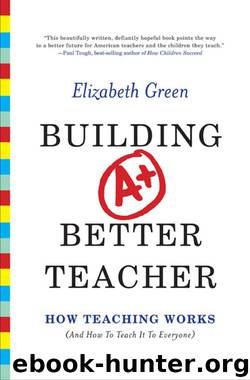Building a Better Teacher: How Teaching Works (and How to Teach It to Everyone) by Elizabeth Green

Author:Elizabeth Green [Green, Elizabeth]
Language: eng
Format: epub
Publisher: W. W. Norton & Company
Published: 2014-08-04T04:00:00+00:00
Back then, students at the Academy of the Pacific Rim could agree about one thing: they absolutely hated school. “Nothing about school was fun,” Rousseau says. Instead, APR was a parade of rules that dragged everyone down—“like a whipping and ball and chain,” one student told a researcher at the time. Every chair had to be pushed perfectly in, every shirt tucked, every instruction followed, every tooth unsucked and eyeball unrolled. Either that, or you’d find yourself sitting in the dean’s office with Mr. Lemov, explaining how you planned to act differently next time. When students did come to love APR—and many of them did, fiercely—their affection was always bracketed: “love-hate,” said one of the school’s star students and strong admirers, Millisent Fury Hopkins.
Rousseau’s first memory of APR was from the second day of school, which was also the first time he got suspended. The class was working on an activity called Math Minutes, in which students competed to see how many math problems they could solve in a minute. “So I got through them, I finished, I did it, and I celebrated,” Rousseau says. “I was like, ‘Yesssss!! I got 100 on my Math Minute!’ ” The next thing he knew, he was being sent to the office. From there, he was sent home early for disrupting class.
“I was terrified,” he says. Rousseau was a talker, yes, and a class clown, but he was not a bad kid. “Please don’t do this!” he pleaded. But he had called out, disrupting his class, so they sent him home. The pattern was set. Practically every day, a teacher would send Rousseau out of class. Sometimes it happened three or four times. Most of his offenses were like that first Math Minutes celebration. No matter how hard he tried, he always seemed to find himself talking when he was supposed to be quiet, making a comment when he hadn’t been called on, joking around when he should have been working. Suspensions piled up. Sometimes he got suspended three times in one week.
The flip side of Stacey Boyd’s “broken windows” theory of discipline—squashing the littlest signs of disorder before they exploded into chaos—was that students spent a lot of time inside the dean’s office. According to the school’s annual report, in the 2002–03 school year, when Rousseau was a junior, 38 percent of students received at least one out-of-school suspension. That was down from 58 percent the year before. The combined suspension and expulsion rate in the traditional Boston Public Schools, meanwhile, was estimated at 6 percent for all students and 8 percent for black students.
Punishments at APR could be embarrassing. An untucked shirt yielded “shirt tuck-in exercises”—a calisthenics routine performed in view of the whole school. “You know, we touch our toes, we reach for the sky, we jump, and then we have to tuck our shirt back in,” says Kevin Thai, a member of the school’s first graduating class. With every jump, the offending shirt untucked itself again, requiring another round of calisthenics.
Download
This site does not store any files on its server. We only index and link to content provided by other sites. Please contact the content providers to delete copyright contents if any and email us, we'll remove relevant links or contents immediately.
| Administration | Assessment |
| Educational Psychology | Experimental Methods |
| History | Language Experience Approach |
| Philosophy & Social Aspects | Reform & Policy |
| Research |
The Art of Coaching Workbook by Elena Aguilar(48064)
Trainspotting by Irvine Welsh(20055)
Twilight of the Idols With the Antichrist and Ecce Homo by Friedrich Nietzsche(17705)
Fangirl by Rainbow Rowell(7834)
Periodization Training for Sports by Tudor Bompa(7328)
Change Your Questions, Change Your Life by Marilee Adams(6641)
This Is How You Lose Her by Junot Diaz(5771)
Grit by Angela Duckworth(4736)
Red Sparrow by Jason Matthews(4665)
Asking the Right Questions: A Guide to Critical Thinking by M. Neil Browne & Stuart M. Keeley(4574)
Paper Towns by Green John(4169)
Room 212 by Kate Stewart(4107)
Ken Follett - World without end by Ken Follett(3972)
The Sports Rules Book by Human Kinetics(3588)
Housekeeping by Marilynne Robinson(3401)
The Motorcycle Diaries by Ernesto Che Guevara(3332)
Introduction to Kinesiology by Shirl J. Hoffman(3299)
Exercise Technique Manual for Resistance Training by National Strength & Conditioning Association(3291)
Double Down (Diary of a Wimpy Kid Book 11) by Jeff Kinney(3272)
